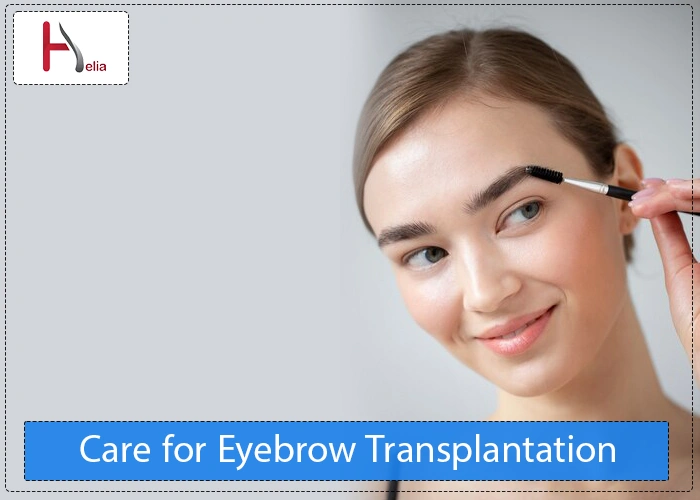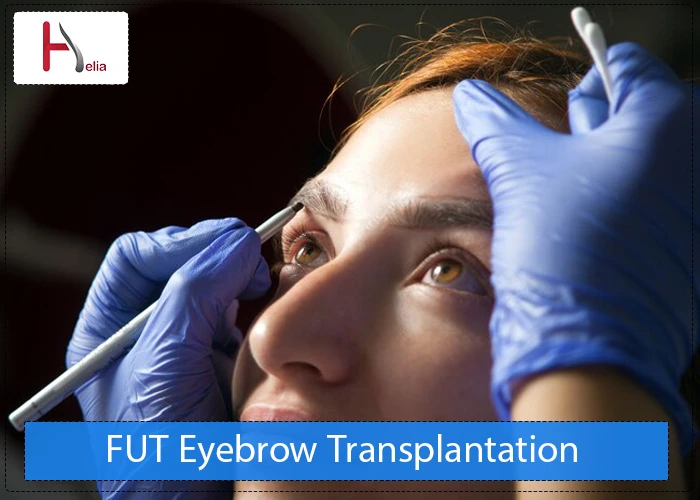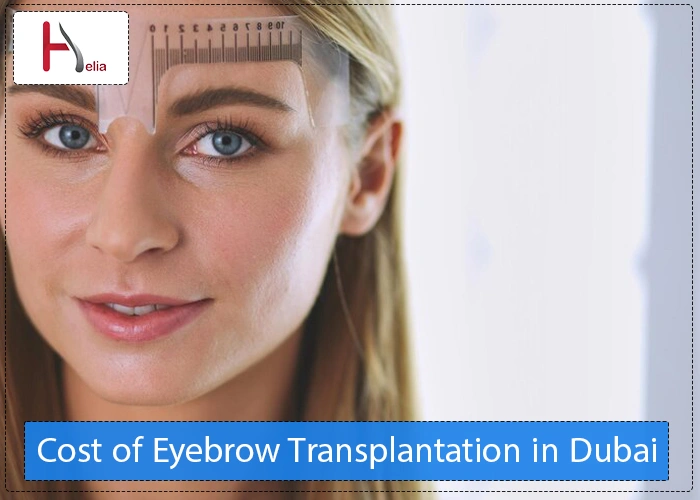One of the advantages of eyebrow transplantation is its durability and longevity. Specialized physicians use parts of the scalp hair for implantation, where the likelihood of hair loss in those areas is close to zero. They often utilize areas at the back of the head with less hair loss and stronger follicles. While it may take some time for the transplanted hair to fully grow and stabilize, after a short period, the transplanted hair will guarantee the beauty of your face and eyebrows. You might wonder about the longevity of natural eyebrow transplantation.
After eyebrow transplantation, the follicles will grow similar to natural eyebrow hair. Therefore, taking care of your eyebrows is essential to prolonging the longevity of the natural eyebrow transplant.
Stabilization Process of Transplanted Hair in Eyebrows
An individual who undergoes natural eyebrow transplantation should wait for approximately twelve months to observe complete results. The first hairs start to grow irregularly and thinly around one month after the transplantation, following the end of the recovery period. In the second and third months, the individual will experience significant shedding of the transplanted hair, which may cause concern. However, there is no need to worry because this shedding is related to the fine hair shafts, and the hair follicles will remain beneath the skin, eventually transforming into thicker hair.
Permanent hair growth and thickening of the eyebrows begin around the fourth month and continue until the twelfth month. Therefore, it is advisable not to judge the outcome of the eyebrow transplantation before the completion of twelve months.
How long does eyebrow transplantation last and what are the results?
In the past, thin and arched eyebrows had many fans and were recognized as part of facial beauty. However, nowadays, there is a different definition of beauty. Wide and natural-looking eyebrows enhance the face’s beauty.
For this reason, individuals with sparse and thin eyebrows are looking for ways to increase the density of their eyebrow hair. Natural eyebrow transplantation is a permanent solution and a suitable option for these individuals because, after the transplantation, there is no need for temporary methods to fill in their eyebrows. Therefore, problems such as skin allergies and potential infections resulting from temporary procedures do not occur.
Eyebrow transplantation has long-lasting results and provides more natural outcomes for the recipients. Although the history of natural hair transplants goes back to longer periods, successful natural eyebrow implants were first performed in 1990.
The eyebrow implant procedure appears to be much more complex than hair transplantation because it requires great precision. Pre-designing the eyebrows, identifying the points, and determining the eyebrow line are essential requirements for natural eyebrow transplantation. What matters is the correct angling of the eyebrow strands so that they align with each other. Otherwise, it will hurt eyebrows and facial aesthetics. In the following, we intend to discuss the influential factors and important points regarding increasing the longevity of natural eyebrow transplantation.
To inquire about the cost of eyebrow transplantation and receive free specialized consultation over the phone, please contact the beauty consultants at Helia Skin and Hair Clinic at +98 2179547. You can also communicate with our consultants via WhatsApp chat at +971561004050 and benefit from free specialized consultation.
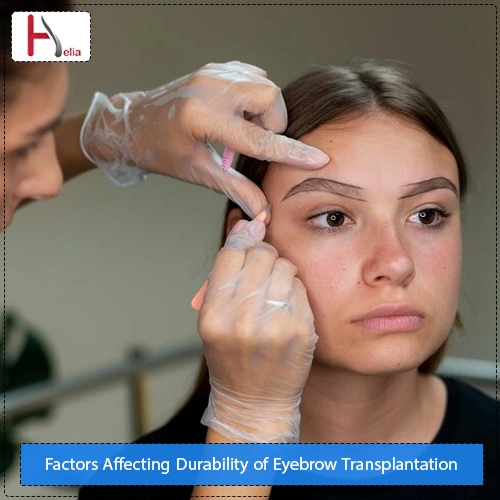
Factors Affecting the Longevity and Durability of Eyebrow Transplantation
In addition to the technique used by the physician during eyebrow transplantation, other factors such as selecting appropriate follicles for transplantation, post-transplant eyebrow care including washing the eyebrows after the procedure, the individual’s diet, and the nature of the eyebrows, all have an impact on the longevity of the eyebrow transplant. For example, during the transplantation, the physician should choose follicles that have high resistance against shedding; follicles from the back of the head area are the best for transplantation. On the other hand, during the follicle extraction process, the physician should use advanced methods that have high efficiency and extract the follicles with minimal damage from the donor area.
Excessive grooming after eyebrow transplantation, coloring the eyebrows before the follicles have fully grown, and engaging in strenuous activities during the recovery period can reduce the longevity and durability of the eyebrow transplant.
How long does it take for eyebrows to grow after transplantation? This is one of the common questions asked by clients at Helia Clinic. Stay with us until the end of the content to learn about the stages of eyebrow growth after transplantation in detail and with specific explanations.
Reasons for the Thinning of Eyebrow Hair after Eyebrow Transplantation
Several factors can contribute to the thinning of eyebrow hair after undergoing the eyebrow transplantation process. In this regard, individuals should first identify the underlying causes and take steps to improve the growth process of their eyebrows. Some common factors and causes of thinning of eyebrow hair are as follows:
- Visiting unreliable clinics
- Low level of experience of the treating physician
- Skin and eyebrow hair type of the patients
- Quality of the hair bank
- Failure to follow recommended post-transplant care measures
- Sleeping in improper positions
- Experiencing impact or trauma to the transplanted area
- Engaging in heavy activities and sports
- Exposure to direct sunlight in the early days after transplantation
- Exposure to hot water pressure in the early days after transplantation
- Entering pools, the sea, and saunas in the early days
- Using cosmetics and chemicals in the first two weeks
- Massaging and applying excessive pressure to the transplanted area
- Using tweezers in the first week
- Consuming alcohol, tobacco, and cigarettes
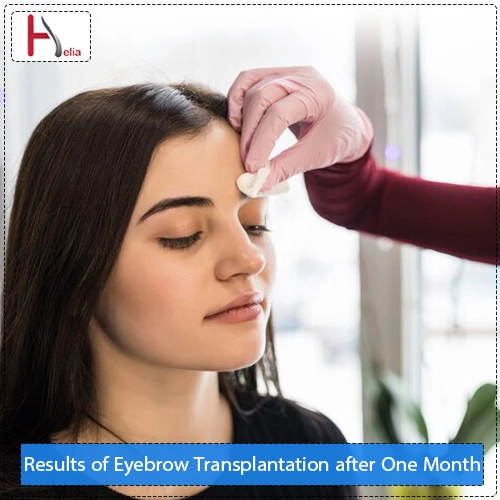
Results of Eyebrow Transplantation after One Month
What happens after an eyebrow transplant? You may be eager to find out what happens after an eyebrow transplant or even want to see your new appearance in the first month. However, we recommend being patient because achieving permanent results, especially in natural eyebrow grafting, requires more patience and perseverance. In the first month after the eyebrow transplant, you may observe subtle eyebrow growth. Additionally, the localized redness at the site of the procedure will subside, and the skin will return to its natural state.
When Does Hair Shedding Start a Few Days After Eyebrow Transplantation? The onset of hair shedding after transplantation gradually occurs one month after the eyebrow grafting procedure. Therefore, experiencing such symptoms in the first month after the surgery should not be alarming. It is also possible to feel itching in the transplanted area at times, which can be a good sign of healing in that area after the eyebrow transplant.
What results can be expected after three months of eyebrow transplantation?
Approximately three months after eyebrow transplantation, the phase of hair shedding enters a new stage. This is the phase where anagen effluvium occurs. During this stage, the follicles that were implanted during the procedure may experience shock and shedding, which can be concerning for individuals who are not aware of this natural process necessary for eyebrow growth after transplantation. This type of shedding should not only cause concern for those who have undergone the eyebrow grafting procedure but can also indicate the success of the procedure.
During this stage, any side effects or scars from the surgery will be resolved, and the hair growth process will begin. From the third month onwards, you can expect the hair growth to accelerate, and gradually, the eyebrows will transition from their previous state and become denser.
What will eyebrow transplantation look like after one year?
Fortunately, natural eyebrow transplantation allows you to have thick and well-shaped eyebrows without the need for artificial and temporary cosmetic methods. The process of eyebrow transplantation has a significant similarity to natural hair transplantation on the scalp. All individuals seeking eyebrow transplantation desire to have beautiful and thick eyebrows after one year.
In general, it should be noted that after the completion of eyebrow transplantation, it takes approximately 6 to 9 months to see the initial results. However, in general, 90% of the transplanted eyebrows will be visible between 9 to 12 months, and you can observe the outcome of the transplantation. The maximum density of the transplanted hair in the eyebrows becomes apparent after one year.
If the follicles have been properly placed by the specialist in terms of angle and depth, you can notice the growth pattern of the transplanted hairs within the first 6 to 7 months. However, the final result will be visible after one year. During this year, you should follow a specific schedule and visit the specialist for the evaluation of the transplanted hair.
Since the transplanted hairs in the eyebrows continue to grow like any other hair, you can groom them to achieve a better shape. However, allow the transplanted hairs to grow sufficiently before attempting any corrections.
What is recommended after mesotherapy for eyebrow transplantation?
Mesotherapy is considered a modern and innovative method for enhancing transplanted eyebrows. In this advanced therapeutic method, based on the diagnosis of a specialized physician, certain therapeutic drugs, minerals, and strengthening medications are injected around the eyebrow transplantation site.
During this treatment process, the mentioned substances are injected into the middle layer of the eyebrow skin using fine needles, targeting areas with the highest density of follicles. The absorption of these substances at the mentioned level promotes follicle strengthening and prevents eyebrow shedding.
The diagnosis and application of mesotherapy after eyebrow transplantation require expertise and are prescribed in certain conditions. Some individuals who are candidates for mesotherapy after eyebrow transplantation include:
- Individuals with thin hairs that are not genetically determined.
- Individuals who are eager to observe desired eyebrow growth signs.
- Individuals who are at risk of significant eyebrow loss after the transplantation procedure.
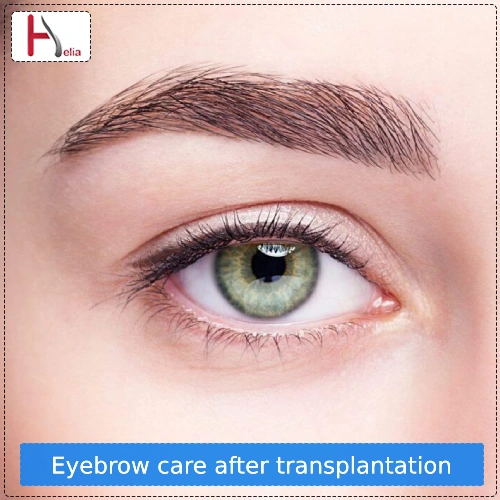
Eyebrow care after transplantation
Achieving a natural appearance after eyebrow transplantation is one of the concerns of individuals seeking the procedure. In this regard, the angle and direction of the transplanted hairs should align with the natural eyebrow line and other hairs. Engaging the services of the best eyebrow transplant doctor with experience and performing the procedure in well-equipped clinics, as well as the preparedness of individuals, are among the influential factors in achieving natural-looking eyebrows. Additionally, achieving an ideal eyebrow shape after transplantation depends on other factors and conditions, which we will discuss further:
- Proper consultation and planning.
- Skillfulness of the performing physician.
- Quality hair bank.
- Using the FUE method.
- Using the DHI method.
- Avoiding direct sunlight.
- Avoiding swimming pools and the sea.
- Avoiding saunas in the early days.
- Avoid exposure to hot water during showers.
- Avoiding heavy activities in the first two weeks.
- Avoiding tobacco and smoking.
- Avoiding alcohol and blood thinners.
How long do the results of eyebrow transplantation last?
The longevity of eyebrow transplantation results significantly depends on the beauty service provider and the performance of the specialist. If you take proper care of your eyebrows in the initial months following the implant, you can achieve long-lasting natural-looking eyebrow grafts. It’s important to note that the likelihood of all hair follicles successfully regrowing is very low because follicles may get damaged during the transfer process or other factors may prevent hair growth. Therefore, this technique usually requires touch-up sessions to replace follicles that did not successfully graft and to correct the growth direction of any improperly growing hairs.
| Timeframe | Results of Eyebrow Transplantation |
| One week | Formation of scabs on the eyebrows Swelling and bruising Crusting of the transplanted follicles |
| One month | Itching and flaking in the transplant areas Numbness in the donor area and transplant site due to tissue and nerve damage Irregular growth of transplanted hairs |
| Three months | Sudden shedding of transplanted follicles, also known as shock loss |
| Six months | Regrowth of newly transplanted hairs Settling of the eyebrows and regular growth Possibility of hair styling and coloring Achieving the desired and natural-looking results |
Are the results of eyebrow implants permanent?
Is eyebrow transplantation permanent? Generally, one of the goals individuals have when seeking eyebrow transplantation is to achieve permanent results. That’s why they often ask this question during their initial session, whether eyebrow transplantation is permanent or limited to a specific period. It is possible that in some cases, particularly two years after the procedure, there may be a sudden loss of eyebrows. Therefore, contrary to what is stated in the definition of this type of procedure, which suggests that eyebrow transplantation can be considered a permanent procedure, it is necessary to modify this definition. Although this technique is considered to have high durability, it is not the case that eyebrow regrowth after transplantation is considered lifelong.
Factors such as the skill, knowledge, and experience of the surgeon, the presence of diseases, certain complications, and even the effects of surgery-related injuries from various incidents can result in shorter longevity of the transplanted hairs. However, it should not be denied that if the procedure is successful, the effects and results of this procedure can last for many years.
Reasons for eyebrow transplantation after one year
As mentioned earlier, there is a direct correlation between the treatment process and the treatment methods used for hair transplantation in the scalp and eyebrows. During a standard treatment process, follicles retain their inherent characteristics and continue to grow throughout their lifespan. The results of eyebrow transplantation can be permanent, but their longevity also depends on other factors. Gender, appropriate age for eyebrow transplantation, genetic conditions, lifestyle, diet, and other factors can influence the lifespan and regrowth of eyebrow hair.
If reputable follicle banks are used for eyebrow transplantation and the transplanted follicles are of sufficient quality, much more desirable results can be achieved. Adhering to the recommended care principles by a dermatologist or hair specialist can also significantly contribute to the continued growth of the transplanted hair.
It is worth mentioning that an increase in the rate of hair loss in the scalp and body is also among the factors that can affect the lifespan of eyebrow transplantation throughout a person’s life. In some cases, individuals may require more than one eyebrow transplantation during their lifetime to achieve the desired outcome.
Ways to Increase the Longevity of Eyebrow Implants
Eyebrow loss in women often occurs due to excessive grooming and the use of non-standard cosmetic products. However, factors such as genetics, naturally sparse eyebrows, and conditions like cancer can also contribute to eyebrow loss. There are simple yet important recommendations that should be followed after undergoing eyebrow implants to enhance their longevity:
Use standard cosmetic products
Non-standard cosmetic products such as eyebrow shadows and pencils can cause inflammation and itching on the skin, accelerating the process of eyebrow loss. It should be noted that individuals who are sensitive to standard cosmetic products should also avoid using eyebrow pencils and shadows. Standard eyebrow pencils and shadows from reputable brands will not cause eyebrow loss.
Avoid thinning your eyebrows
Eyebrow grooming trends change over time. If the longevity of your eyebrow implants is important to you, avoid grooming the implanted hairs for a certain period. Therefore, it is recommended to choose a style that suits your face during the eyebrow implant procedure, regardless of current trends. This way, you will always have a beautiful and appealing appearance. Remember that true beauty lies in the harmony between facial features.
Carefully follow the prescribed medications by your doctor
After natural eyebrow implantation, the specialist may prescribe some types of follicle-strengthening medications to enhance the transplanted hair. Exercise caution and patience when using these medications, as the follicles are more susceptible to damage in the initial days after the procedure. Strengthening the transplanted eyebrow hair follicles will enhance their longevity. It is advisable to read articles on eyebrow strengthening after the implantation process to promote growth and longevity of the transplanted eyebrows.
Avoid touching the implanted area
During the recovery period after the implantation, you may experience itching at the site of the implants. Under no circumstances should you scratch or rub the eyebrows. As mentioned before, damaging the hair follicles in the early days after the procedure can affect the results and longevity of the eyebrow implants.
Home remedies for strengthening eyebrows are also ineffective
Using bitter almonds, olive oil, peanuts, eggs, and other similar substances for strengthening eyebrow hair is ineffective. It should be noted that these substances will not work miracles. If the hair follicles are lost, no method can revive them. These home remedies only strengthen existing hair follicles.
Increasing the Longevity of Eyebrow Implants at Helia Clinic
In previous sections, we discussed effective strategies to increase the longevity of eyebrow implants. It’s important to note that post-implantation care plays a significant role in the success of the grafting procedure. Therefore, after the implantation, paying attention to these care tips is essential. At Helia Beauty Clinic, experienced specialists perform eyebrow implants using state-of-the-art knowledge and techniques. Entrust the process of grafting your eyebrows to our experts at this clinic and await the best results with peace of mind. After the eyebrow implantation, the doctor will provide you with care instructions to enhance the longevity of the implanted eyebrows. It is crucial to adhere to these instructions with utmost care.
Thinning of the implanted eyebrows
One common concern that many individuals seeking eyebrow implants have is the issue of thinning of the implanted eyebrows after the treatment process. Regarding the occasional thinning of a few eyebrow hairs, there is no need to worry; however, skin and hair specialists encourage individuals to follow initial care practices and educate them about actions that may cause thinning of the eyebrows.
Frequently Asked Questions about Eyebrow Implants
Some common questions that people often ask after natural eyebrow grafting and seek information in this regard include:
Can I ask the surgeon to perform the eyebrow implantation according to my desired shape and design?
Yes, you can discuss your desired design for the eyebrow implantation with the surgeon if you wish. However, in this regard, most doctors consult with you before performing the grafting procedure and seek your opinion. Therefore, if you have a reasonable and thoughtful design that is feasible, your doctor will certainly welcome this idea.
Is it possible for the eyebrow hairs that have fallen out to regrow?
Answer: Yes, it is possible that in some cases, the eyebrow hairs that have fallen out may not regrow. Additionally, in these conditions, hair growth may completely cease or occur at a slower pace. Some of these cases may be attributed to the absence of suitable hair for eyebrow grafting. In other cases, failure to follow the doctor’s post-operative instructions may hinder the regrowth of hair in the eyebrow area.
Does eyebrow shedding occur after a natural implant?
The amount and duration of eyebrow shedding after the implantation process depends on various factors. This experience varies among individuals due to genetic factors and the implantation technique, which can significantly affect hair shedding during the recovery period.
In general, based on available statistical information, shedding of transplanted hair within 1 to 5 weeks after the implantation process is considered normal. In most cases, individuals may be concerned about the shedding of the implanted area for several months after eyebrow implantation. It is important to be aware that if the eyebrow implantation is performed at reputable clinics, the shed hairs will eventually regrow.
When will the final result of the eyebrow implantation be achieved?
Typically, the final result of the eyebrow implantation will be visible after 10 months to one year, and in some cases, between 4 to 6 months after the implantation procedure. During this time frame, individuals can observe the actual density of their eyebrows. However, you may be able to see the thickness and shape of the eyebrows shortly after the procedure.
How much does eyebrow implantation cost?
The cost of eyebrow implantation depends on the type of clinic, the services provided, and the surgeon’s fees. Generally, a significant factor in determining the cost of eyebrow implantation is the number of grafts required for the eyebrow transplant. In other words, the more hair strands needed for the procedure, the higher the cost will be.
How long does eyebrow shedding continue after the implantation?
Keep in mind that the shedding phase of the eyebrows often occurs within the first 20 days after the eyebrow implantation procedure. After this period, particularly between 40 to 50 days post-surgery, individuals can lose even more hair from their eyebrows. In some cases, all of these hairs may shed. After this period, the growth phase of the implanted hairs begins.
This means that hair shedding during the shedding phase of the eyebrows after the implantation stops, and the process of strengthening the hair roots noticeably begins. In other words, the period between 50 to 60 days marks the cessation of eyebrow shedding. The growth phase will continue for another two months. If extensive hair shedding persists during this period, it is important to inform your physician.
How long does eyebrow implantation take?
Answer: Eyebrow implantation is considered a surface procedure. In this type of method, the individual undergoes local anesthesia, and general anesthesia is rarely used by the physician for this purpose. In the second step, the physician creates incisions in the area where the hairs will be harvested and also creates incisions in the eyebrow area that has been examined and diagnosed by the physician. The total duration of this procedure can range from 4 to 6 hours, depending on its extent or limitations.
If the procedure is performed on a smaller scale, it can take between 2 to 3 hours. In general, the number of transplanted hairs can affect the duration of the eyebrow implantation. The required volume of hair for eyebrow implantation, along with the surgeon’s skill and experience, can also be influential factors in reducing or increasing the duration of the procedure.
When can Botox be done after eyebrow implantation?
Answer: Generally, it is necessary to be patient for Botox. The time interval of three to four months can be a suitable period for performing eyebrow Botox. During this time, you can consult with the necessary experts and plan accordingly. This is usually the time when most individuals who have undergone eyebrow implantation realize that they have not achieved the desired results. It means that the transplanted hairs do not have the desired quality, or there is a need to use alternative methods such as Botox, based on the physician’s diagnosis, to correct the eyebrow shape and other common issues in that area.
In general, for Botox and other facial areas, doctors recommend waiting at least one week until the swelling and wounds from eyebrow implantation in that area have subsided before performing the Botox procedure.
Another concern of eyebrow implantation patients is whether the transplanted hairs will regrow or not.
The answer to this question depends on the expertise and certification of specialized physicians. Reliable and skilled physicians have direct knowledge of the regrowth of transplanted hairs.
You can visit “Helia Specialized Dermatology, Hair, and Beauty Clinic” to get information about the cost of eyebrow implantation by consulting experienced specialists. For consultation, you can call the number +971561004050.
Additionally, you can benefit from online consultation through the website’s chat system. Hair and eyebrow transplantation at this clinic are performed by Dr. Hamidreza Khorasani, a renowned physician in the country.


